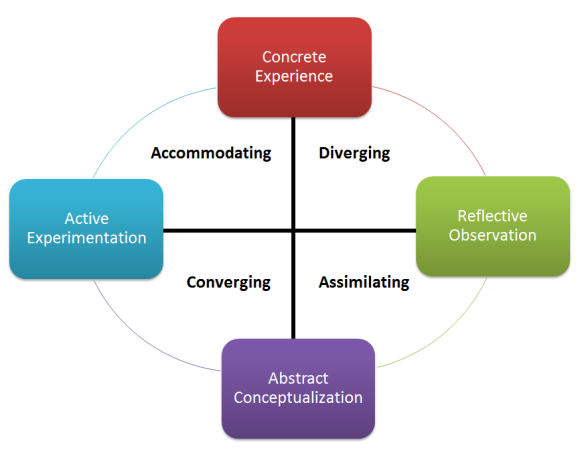Recently I’ve been thinking a lot about learning styles. Settling into a new job requires a lot of learning, and at this point in my career most of this learning involves internal policies, processes, and politics. Or as I’ve been told by a few, mostly just politics.
I’ve been reminded how often times the teacher teaches to their preferred learning style. Everyone is guilty of this, myself included. It takes careful, deliberate effort not to teach solely to your particular style.
If you believe that learning styles exist, there are plenty of approaches to learning styles. Since I had a sip from ACRL’s Immersion Kool Aid, I tend to keep Kolb’s Learning Styles as a model in the back of my mind. I also think that the VARK model has a lot to offer, especially in regards to active learning.
So let’s review Kolb’s Learning Styles Inventory with the graphic below (If you adhere to the VARK model, sorry auditory and kinesthetic learners) …
Another way to think of it:
- Concrete experience = doing
- Reflective observation = observing
- Abstract conceptualization = thinking
- Active experimentation = planning
You can take a fancy test to determine where you fall. I tested as an Assimilator. If you look at the career characteristics for Assimilators, it’s basically a librarian.
Whether you follow Kolb’s model or another model, what’s important to remember is that everyone learns differently. Just as we try to teach to different learning styles in the classroom, new employee training and professional development training should attempt to teach to different learning styles too. In my case, my new supervisor has created a flexible training environment, capable of molding to how I learn best.
Some will argue that learning styles are a myth. They may be right, but I like to think there is a middle ground and that ground is providing multiple ways to learn the same thing. Teach the same material in different ways. If you can know how your students learn most effectively, that’s ideal, but librarians usually don’t have the time to know students at this level. So we diversify how we teach to reach as many students as possible. We diversify to engage, and when students (or new employees) are engaged with the content, they will learn.

